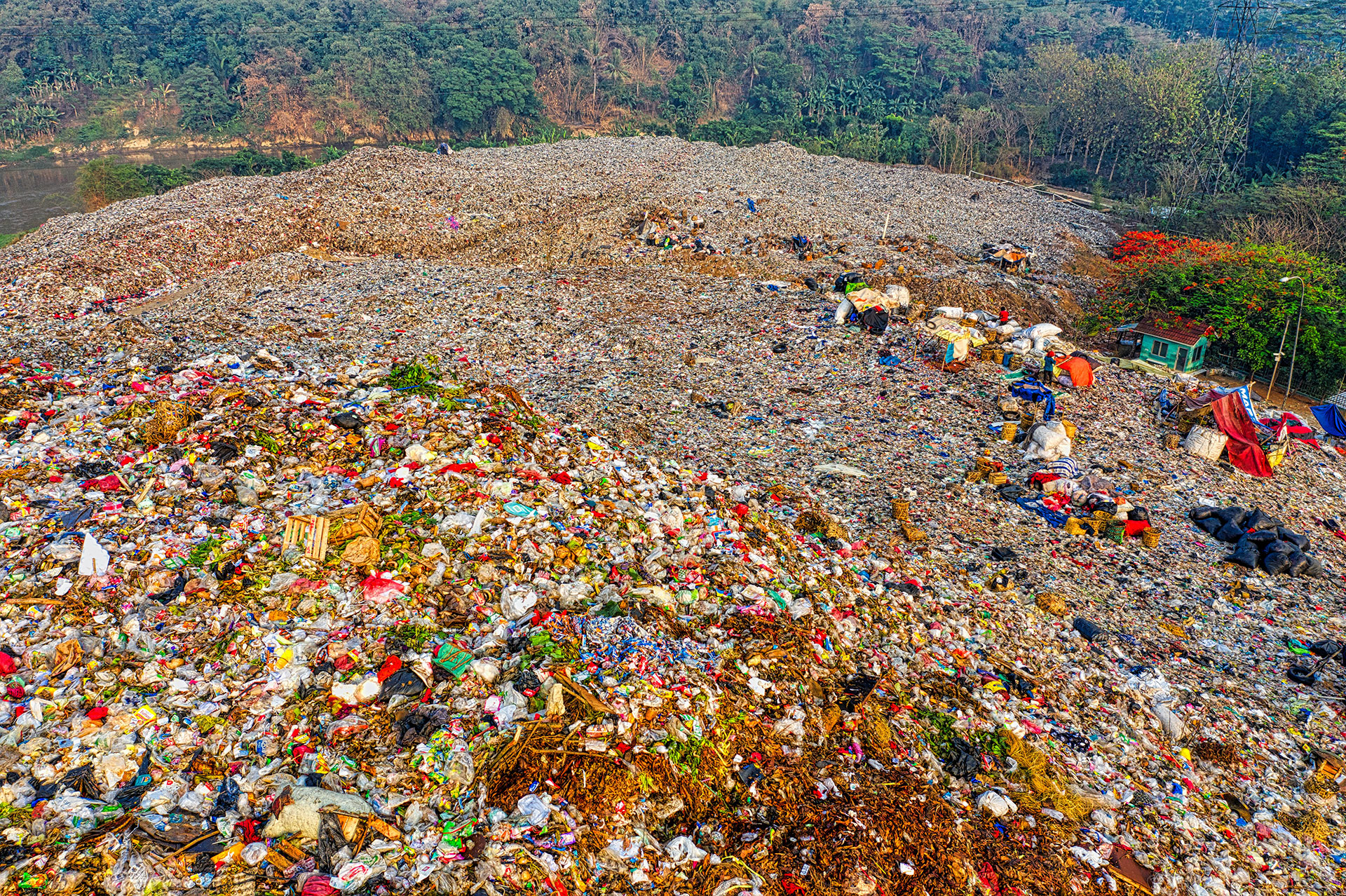In the United States of America alone, there are over 2,000 landfills in the USA, almost 300 with less than 10 years of capacity remaining. What makes it worse is that plastic production is expected to increase significantly, and with the ongoing difficulties of exporting municipal solid waste to other countries, you can see that there is a very big problem brewing.
The most difficult fact that we as individuals need to grasp is that landfills (that contain plastic and harmful elements) are a recent invention, the first recorded landfill is only dated back in the 60’s and 70’s. If this situation has become this severe in a matter of 50-60 years, it is hard to imagine what our planet will be like in 50 more years.
Not every landfill is as bad as what you are about to read, but it’s also important to understand that several countries do not have the infrastructure to build and maintain safe landfills. Many countries have dump sites, giant piles of garbage, or worse, the people are left with no resort so they end up dumping their garbage in the local rivers.
Unfortunately, these are not the only problems we are facing with landfills, and in this post, I’m going to share with you 5 reasons why we need to make landfills our last option for eliminating waste and garbage.
As you read, take into consideration these three concerns:
- The amount of landfills and their remaining capacity vs. the expected growth of plastic production
- The risks and dangers of landfills and the amount of landfills across the world
- The lack of space and approved locations to build new landfills

Photo by Bakhrom Tursunov on Unsplash
#1: Landfill’s Are Like Earth’s Black Hole
What goes into a black hole does not come back, right? Now, I’m not an expert in astronomy or waste management, so definitely do your own research and let me know what you find, but the more I think about it, landfills are kind of like a black holes. They swallow whatever goes in, they don’t give it back.
Ok, maybe the concept of things never coming back is more closely related to landfills. Because the differences are that landfills don’t actually make things vanish, they just consume and hold waste, which has great potential of being extremely dangerous to all living things, plants, beings, and our lovely ecosystem.
So what is being dumped into a landfill? The short answer is basically ANYTHING.
It is appalling to me that brand new products are tossed into landfills, never to be seen again. Resources that are expensive, in great condition, and even rare, are lost in the giant black mountain, I mean hole.
Amazing furniture, perfectly good lumber for building, brand new items are just tossed out. I have a sister who lives very near to a landfill and she has told me some of the items that people bring. One item was an RV, fully functional and in great condition!! And the reason it was being sentenced to the landfill black hole of death was because it was for a construction site and they were done using it.
Anything you don’t want anymore, you can just throw it out and trucks will drive it away to the morgue, I mean the landfill.
Toxic waste is also dumped in landfills. Thankfully, at more advanced landfills, they are getting better at avoiding dumping toxic waste into the landfills, but it still happens. And it is definitely not monitored well in garbage dumps, or lower income areas.
Let’s talk about food waste for a second. The EPA stated that, “The estimated 35.3 million tons of wasted food that went to landfills in 2018 represents 24.1 percent of all MSW landfilled.” That’s a lot of food! And a lot of resources that could have been diverted to be more useful.
When you throw away expired food into the garbage, things like fruits and veggies, and plant matter, those items are nutrition for the Earth. However, when it enters a landfill, it doesn’t come back out, and it doesn’t break down like it would as compost due to lack of oxygen and other reasons. Instead, it most often becomes toxic fuel for methane gasses which pollutes the air and of course contributes to the greenhouse gas problem.
We could have used that food to build up our soil biodiversity and health. And yes, our soil NEEDS help desperately. Mass agricultural farming and pesticide use at home has depleted our soil of many needed nutrients. Although it was meant for good, the use of chemicals has caused severe degradation of the soils micro-nutrients, and leaving our crops and land to produce nutrient deficient food.
Okay okay, back to the black hole concept…Whatever goes in never comes out, never gets used again, and takes hundreds and hundreds of years to decompose.

Photo by Muhammad Numan on Unsplash
#2: Landfills Cause Massive Pollution
Did you know that there are hundreds, if not thousands of landfills “quietly poisoning” us, (sourced from Balkan Green Energy News). In fact, it’s a well known fact in the waste management industry that landfills can cause extreme danger, hazard, toxicity, and great harm to living beings, plants, and our Ecosystem.
With over 3,000 active landfills in the United States alone, how many do you suspect are leaching toxins into our soils, waterways, air, and inevitably into our food and drinking water? We can agree that landfills have “improved” over the past few decades, the way they are designed is typically safer, but they are still very dangerous. I’d love to be proven wrong.
Even a well built landfill becomes deadly if it starts leaking or catches on fire. In spring of 2019, a landfill in Guadalajara, Jalisco burned for weeks, with firefighters and helicopters dumping thousands of gallons of water on it daily. The air quality became incredibly toxic. Interestingly, locals complained that the landfill was supposed to be closed 11 years prior.
Waste Dive and Balkan Green Energy News have written about landfill capacity and toxic leaching, you can check out their articles as well.

Photograph by Chris Jordan chrisjordan.com
#3: Landfills Are Killing Wildlife & Our Ecosystem
It is very common to see birds swarming in the air at most landfills. Actually, it is very UNCOMMON to not see birds at landfills. They are attracted to the food so they come for what they think is a feast, and they invite all their bird cousins, aunts, uncles, and all their friends… and enemies, too. Think of the animals that get into your trash like pesky racoons, dogs and cats, and other local wildlife such as bears, possums, squirrels, and so on.
At landfills, animals can get caught in the trash, run over by the large equipment, they can eat deadly materials that cause them to get ill and die… They can carry diseases, trash, and other dangerous and hazardous materials around the world, too. It’s just not a good place for our wildlife to be!
Wildlife comes to landfills, but the toxicity and dangerous chemicals from landfills leach out into the surrounding wildlife, water systems, soil, and air. Roadrunner Smarter Recycling wrote that “These toxins can seep into soil and groundwater aquifers and affect local ecosystems, animal-life, and our drinking water.”
This is not an extreme assumption, it is really happening. And it’s even worse with landfills and dump sites that do not have advanced technology to somewhat contain the toxicity.
This is a snapshot from one of my favorite resources on garbage pollution, Waste Dive. They wrote about the subject of leaky landfills in the UK, some landfills are poorly lined or not at all, and are leaking major toxins, which has become a public health and environmental concern.

Photo by Random Person on Unsplash
#4: Landfills Have Trained Us To Be Wasteful
Originally, landfills were meant to be helpful, and when hardly anyone needed to purge unwanted junk, they were relatively safe and helpful. Unfortunately, they’ve become an easy resource for millions of people to get rid of whatever they don’t want anymore. Including perfectly good (even brand new) products and resources.
Out goes the old, in comes the new. And with the simplicity of throwing out your trash comes the need to buy new things! Oh wait.. maybe it’s the other way around? Or both ways? Hmm. You get my point, right?
Because it is SO easy to throw things away, and because our trash gets taken away, buried, or dumped somewhere else, it doesn’t matter to us, so we think we can keep living to buy and toss whatever we decide. You see? Oh wait… you don’t see. Because it’s buried in a landfill. And that’s the philosophy of “out of sight, it doesn’t exist”, right? But it does exist, doesn’t it?
Well, in any case, like a phone case, people want the newest phones, tablets, gadgets, toys… We envy what we don’t have, we want the newest clothing styles, nice things, pretty things, the best things… I’m pretty sure that list of things people want is literally ENDLESS. In the past few generations, we have become an excessively possessed “consumer culture”, and a wasteful consumer culture at that!
“Every year we dump a massive 2.12 billion tons of waste. If all this waste was put on trucks they would go around the world 24 times. This stunning amount of waste is partly because 99 percent of the stuff we buy is trashed within 6 months.”

#5: Landfill Capacity is Dwindling
This might be the last point on this post, but it’s important to know that there are many other reasons that landfills should be our last resort for garbage management.
It is hard to imagine this to be true, but there are less and less permits being released for landfills in the U.S. because there are not very many “approved locations” to build new landfills, and since many landfills are reaching capacity, this creates a major problem. At Global Citizen, it was noted that “The US generates more than 258 million tons of municipal solid waste each year”, according to the EPA. Landfills are filling up and will soon be out of commission. And of course, consider that in the past 30 years, plastic production has nearly quadrupled, and is expected to continue increasing at an alarming rate.
There are regulations and requirements to build new landfills because they are a toxic hazard to life around them. It really makes me wonder what will happen when we finally run out of landfills, and still have an ever increasing amount of waste production, and it will likely happen in our lifetime, but for sure in the lifetime of our children.
With less and less space for new landfills, and more and more NEW plastic being produced, the math shows that we will soon quite literally have more garbage than the Earth can handle.
Many scientists are agreeing that we are at or nearing a tipping point with garbage pollution. If we don’t make significant changes now, in just 5 years, it could be too late. There is no space for that subject here, but if you want to learn more about it let me know.

Photo by Rinson Chory on Unsplash
Bonus: Garbage Exportation
Many countries, including the USA, Europe, Australia, and more, have been exporting garbage to other countries for years in shipping containers and barges, all with one common goal: Find somewhere else to put their trash.
The question is, why? Doesn’t the US have enough space and the right tools to handle it? Actually, no.
And the reality is that the rest of the world doesn’t either. (Just a small reminder that plastic production is expected to more than triple by 2040).
Millions of tons of garbage is exported daily, sadly into poorer countries without the infrastructure to that amount of waste. It gets dumped in piles, rivers even, and slowly starts choking out the environment, living creatures, aquatic life, and even human life.
It should come at no surprise, but very recently, China banned the import of waste in about 2018, saying that they have been the “world’s wastebasket”, according to HuffPost, for too long. Many other countries are refusing imported waste, too.
Unfortunately, this topic is far too big to include here, so I’ll just have to write about it in a new post.
Conclusion
Landfills are a great danger, a waste, and are most definitely not a sustainable or regenerative source for humanity to thrive with the Earth. When we “throw something away”, we must consider its effect on our planet, because although that one item may be small and not seem to be an issue, millions of tons of garbage is being discarded every year.
There is a real crisis of garbage pollution, but it can be fixed, it is achievable, and it is up to us to make it happen. And yes, it’s going to take some work, but we cannot avoid it. The simplest way to start making serious changes is to change the way we purchase, and change the way we dispose of items.
3 things to remember:
- Be aware of the crisis of global garbage pollution
- Be willing to take ownership and responsibility of waste and garbage
- Realize that your efforts are significant (you could be the beginning inspiration for many people to do the same)
Thank you so much for reading, I hope you got something useful out of this, and will use it to change your life and change the world. Together we can make our future and our children’s future on this planet a bright and beautiful one!
If you liked what you read, would you take a second and share this with someone you think would appreciate it.
***As a disclaimer: I do not claim to know everything about landfills, and you should not believe everything you hear/see/read, you should ALWAYS research it for yourself. In my research, interviews, and watching videos of people who have visited and toured landfills, I’m sharing my observations with you.






0 Comments